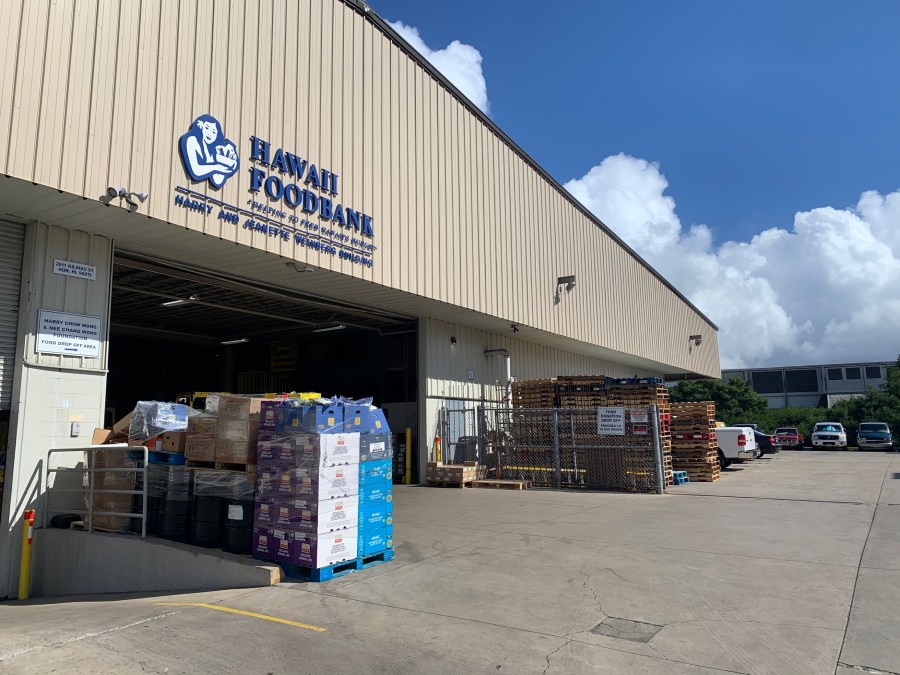HONOLULU (KHON2) — Food insecurity affects families across Hawaiʻi. From Oʻahu to Molokaʻi, food banks provide meals, groceries and community support through partner agencies, churches and mobile pantries.
Each island has a main food bank that connects residents to local resources. There are also smaller food banks that help fill in the gaps. Some are secular while others are affiliated with Catholic charities.
We did a bit of digging and made a few phone calls to find out how the federal cuts are impacting Hawaii’s access to food and how these charities are dealing with the funding cuts.
For those who have the resources to donate: all of the food banks across Hawaiʻi are accepting donations.
Hawaiʻi Foodbank (Oʻahu and Kauaʻi)
“Hawaii Food Bank is serving about twice as many people as we did prior to the pandemic, and about as many people as we did during the height of the pandemic,” said Amy Miller, CEO of the Hawaiʻi Foodbank. “We are on track to distribute more than 25 million pounds of food this year.”
The Hawaiʻi Foodbank serves as the statewide network’s central hub for Oʻahu and Kauaʻi. Its “Find Help” page lists dozens of food pantries, community centers and meal programs on Oʻahu. Residents can search by ZIP code to find nearby partners and distribution times at this link.
“We estimate, I believe there’s about 165,000 people in Hawaii that do receive SNAP benefits — about $58 million a month comes into the state in SNAP benefits,” Miller explained. “We estimate that that’s the equivalent of about 13 million meals every month getting onto the plates of our community members. For some context, that’s about 5.8 times as much food as all of the food banks get into the community every single month.”
On Kauaʻi, Hawaiʻi Foodbank operates its own branch. The Kauaʻi site includes distribution calendars and contact information for partner organizations across the island.
“We’ve already placed orders for about $500,000 worth of additional food coming in so that we can make sure it gets to those who need it,” Miller added. “Statewide, about $4 million worth of food that had been coming into the state to get distributed to our families; that program was cut.”
They are working on applying for non-federal grants to help out with the upcoming holiday season demands.
Kauaʻi Independent Food Bank
Also serving Kauaʻi, the Kauaʻi Independent Food Bank manages its own warehouse and community network.
“We are being indirectly impacted by the federal cuts since the state monies that provide funding receive much of their funding from the Federal Government,” explained Kelvin Moniz, executive director. “Donations have also begun decreasing as more families are needing help themselves.”
Its “Get Help” page offers a current distribution calendar and contact details for pickup sites. Residents can visit their website for updates.
We are having a food giveaway event this Wednesday [Oct. 29] that will benefit workers with TSA and USBA,” said Moniz. “And we are pivoting a bit on how to provide food assistance. We will be supplying the major components of meals to help offset the creation of larger family meals that can be eaten or frozen.”
They are also working on applying for non-federal grants to help out with the demands of the upcoming holiday season. You can click here for food distribution sites.
Maui Food Bank (Maui County)
The Maui Food Bank supports families across Maui County, including Lānaʻi and Molokaʻi.
“With the federal government shutdown threatening the distribution of November SNAP benefits, we anticipate a significant spike in demand for emergency food assistance across Maui County,” said Lisa Paulson, CEO of Maui Foodbank. “Federal food programs such as SNAP, TEFAP, CSFP and WIC play a critical role in feeding our community. Our operations are already stretched, and our team is preparing for an increase in the number of families seeking help, many for the first time.”
Its website provides an interactive map and full lists of partner agencies and food distribution sites. The map highlights churches, schools and nonprofits that help deliver food to remote areas.
“Every dollar donated helps provide four meals, and right now, every contribution has even greater impact,” Paulson added. “We are not cutting programs. In fact, we are working to expand services to meet the rise in need due to the shutdown. Maui Food Bank exists to ensure that no one in our island community goes hungry.”
Information is available on the Partner Agencies and Food Distribution Sites pages.
The Food Basket (Hawaiʻi Island)
The Food Basket is the Big Island’s food bank. Its “Find Food Now” page connects residents with pantries and programs in Hilo, Kona and other communities.
The site features a searchable map and detailed listings of partner agencies. Visit The Food Basket online for updates and locations.
Community pantries on smaller islands
In Lānaʻi City, the Sacred Hearts/Lānaʻi Community Food Pantry provides groceries through the Maui Food Bank network. Contact details appear on local community resource pages.
On Molokaʻi, distribution sites include Molokai Community Health Center, Molokai Baptist Church and The Salvation Army Molokai. These organizations are listed through the Maui Food Bank’s partner agency directory.
How to find food near you
Every food bank keeps an updated list of partner agencies and locations. Residents can visit the official “Find Food,” “Partner Agencies” or “Distribution Sites” pages for their island:
- Oʻahu: Hawaiʻi Foodbank “Find Help” page.
- Kauaʻi: Hawaiʻi Foodbank Kauaʻi or Kauaʻi Independent Food Bank.
- Maui County: Maui Food Bank Partner Agencies and Food Distribution Sites.
- Hawaiʻi Island: The Food Basket “Find Food Now”.
Across Hawaiʻi, these networks continue to ensure access to food for those in need. Families can find support and nourishment in every island community.
